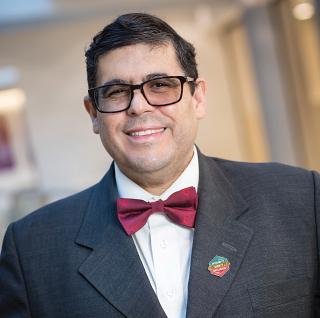Commitment to Health Equity
A conversation with José E. Rodríguez, MD, FAAFP, associate vice president for Health Equity, Diversity, and Inclusion
Our community cannot truly thrive until every Utahn has equal access to the essential elements of living a healthy life. One of the greatest threats to our patients, friends, and families is systemic racism and the inequities caused by it. We believe that systemic anti-Black racism is a public health crisis. That’s why, as a steward of the health of our community, we’re committed to restoring equity and championing anti-racism across our organization.
To make a real difference, we must start with ourselves, committing to becoming ardent anti-racists. An anti-racist institution is one that thoughtfully examines every opportunity for inclusion (admissions, hiring, resident matching, etc.) and eliminates every policy that may permit racism. We’re working to restore equity on every level—from empowering and investing in Black communities and other communities of color to strengthening policies that counter racism and bias and supporting programs that promote social justice.
Most importantly, we vow to listen. We’re committed to learning from patients, colleagues, and community partners who best model anti-racism so that we can be better allies and advocates for the change we want to see in the world.
Anti-racism is not easy, but it’s important. Rodríguez believes we can start with the following declaration: Black Lives Matter.
Why is anti-racism work important in the world of health care?
Anti-racism work raises all boats—when the lives of members of our Black community improve, so do everyone else’s. By rooting out anti-Black racism and white supremacy within our health system, we begin to dismantle and eliminate other forms of bigotry and oppression (e.g. sexism, homophobia, islamophobia, etc.) outside of it. In health care, anti-racism work forces clinicians to examine their practices and recognize that health disparities are caused by systemic anti-Black racism. It means that hiring clinicians from Black and other underrepresented minority groups becomes a priority. It also means speaking out against racism in the workplace toward colleagues and subordinates of color. This is important because it empowers us to work toward equity.
What does that kind of anti-racism work look like long-term?
It should change how we see patients. For example, we know that severe health disparities exist in the Black and Latinx populations, and we know that they are the result of systemic racism. A focus on anti-racist policies will likely reduce (if not eliminate) the health disparities that exist—because we will see patients differently. It will restore equity, which in some ways is the opposite of equality. It will change how we do business.
What’s the difference between equal care and equitable care?
The best example is how we say we “love our children equally.” Let’s say I have four kids, so equality means I spend the same amount of time with each child every day. But today is Thursday, and my daughter Valentina has a project due Friday, so all of my limited time goes to her. And on Friday night, Pablo has appendicitis, so I spend all of my time with him. Equitable love is giving the kids what they need when they need it—sometimes the other kids can’t be attended to at the same time. We don’t love our children equally; we love them equitably. Equitable patient care means giving patients what they need, when they need it—and some will need more than others. If we have Black patients, who have historically and presently been maligned and mistreated by the medical establishment, we must work even harder to overcome the barriers that they face. We must give more of ourselves in that situation, because it’s what’s demanded of us.
What day-to-day changes must occur to restore equity?
We need to validate the experiences of victims of racism. We need to show empathy and then—this is the most important part—take action. Activist Rachel Cargle says it best: “I don’t want your ‘love and light’ if it doesn’t come with solidarity and action.” We need to hire Black faculty, ensure that there is Black representation at all decision-making tables in the institution, then show that we value them through daily acts of kindness.
What does everyday anti-racist behavior look like?
Change the conversations at the water cooler and the break room and stop any conversation that looks racist. When you see behavior that perpetuates white supremacy and racism—micro- and macro-aggressions or incidents of implicit bias—call it out. Especially if you benefit from privilege. In The Lion King, the bad lion has a black mane but the good one has a reddish mane. Disney may not have done that intentionally, but it is a clear example of how deep the roots of anti-Black racism run.
How do we recognize and counteract that kind of implicit bias?
It is very important that we realize that racism is the reason why too many of us associate the color black with “bad.” We need to continue to do self-analysis of our own privileges and biases. Anti-racism work depends on all of us. There will be no change in the mistreatment and murder of innocent Black persons by police and others until the White population stands with the Black population and other populations of color in intentionally rooting out all vestiges of anti-Black racism. Anti-racism work is lifelong work. We have been indoctrinated into a system of racism and bias without, for the most part, even realizing it—and we will spend the rest of our lives dismantling it.

